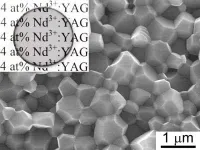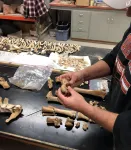(Press-News.org) Plastics are among the most successful materials of modern times. However, they also create a huge waste problem. Scientists from the University of Groningen (The Netherlands) and the East China University of Science and Technology (ECUST) in Shanghai produced different polymers from lipoic acid, a natural molecule. These polymers are easily depolymerized under mild conditions. Some 87 per cent of the monomers can be recovered in their pure form and re-used to make new polymers of virgin quality. The process is described in an article that was published in the journal Matter on 4 February.
A problem with recycling plastics is that it usually results in a lower-quality product. The best results are obtained by chemical recycling, in which the polymers are broken down into monomers. However, this depolymerization is often very difficult to achieve. At the Feringa Nobel Prize Scientist Joint Research Center, a collaboration between the University of Groningen and ECUST, scientists developed a polymer that can be created and fully depolymerized under mild conditions.
Self-healing
'We found a way to produce polymers from the natural molecule lipoic acid in a very controlled way,' explains Ben Feringa, Professor of Organic Chemistry at the University of Groningen. 'It is a beautiful molecule and a perfect building block that was created by nature.' The molecule has a ring structure that includes a sulphur-sulphur bond. When this bond is broken, the sulphur atoms can react with those of another monomer. 'This process was known before, but we managed to find a way to control it and to create long polymers.'
The molecule also has a carboxyl group, which readily reacts with metal ions. These can crosslink the polymers, which results in an elastic material. By dissolving the molecule in water with sodium hydroxide and then evaporating the water, a firmer polymer film is produced through ionic bonds. As the polymerization is achieved through reversible bonds, the material is also self-healing, explains Feringa: 'When it is cut, you can simply press the ends together and they will reconnect in a few minutes.'
Fully reversible
Most of the work in the Materials paper was carried out by Qi Zhang, first as a PhD student at ECUST in Shanghai and later as a postdoctoral researcher at the University of Groningen. 'Lipoic acid is a natural small molecule with an elegant structure,' he says. 'We didn't have to do any tedious re-designing of the monomer to achieve a fully reversible polymerization.' Simply exposing the polymers to sodium hydroxide dissolves the polymers into monomers. 'By adding a little acid, the monomers precipitate and can be recovered. The quality of these recycled monomers is identical to that of the original material.'
'Our experiments show what is possible with these monomers,' adds Feringa. 'We can even recycle the material into monomers several times, without loss of quality.' However, industrial applications of this new polymer are a long way off. Feringa: 'This is a proof of principle. We are conducting experiments now to create polymers with new functionalities and to better understand the polymerization and depolymerization processes.' Furthermore, although 87 per cent of the monomers can already be recovered, the scientists want to get as close to a hundred per cent as possible. 'Our experiments show that we can produce, in a controlled fashion, hard and soft, elastic polymers that can be fully depolymerized,' Feringa sums up. 'This molecule is really very promising.'
The work that was described in the Matter article was carried out at the Feringa Nobel Prize Scientist Joint Research Center. The Research Institute is led by 2016 Nobel laureate in Chemistry Ben Feringa and Professors Da-Hui Qu and He Tian. Feringa received an honorary professorship at ECUST in November 2016. The Feringa Nobel Prize Scientist Joint Research Center was officially opened in October 2017.
Simple Science Summary
Plastics are made of long molecules called polymers. These polymers are chains of smaller building blocks, the monomers. A problem with the recycling of plastics is that the polymers must be broken down into monomers. This depolymerization often reduces the quality of the monomers. Scientists from China and the Netherlands have now found a way to produce polymers (plastics) from a natural monomer called lipoic acid. These polymers can be broken down under mild conditions without a loss of quality. Some 87 per cent of the monomers can be recovered and then reused several times over. This shows that it is possible to create fully recyclable plastics.
Reference: Qi Zhang, Yuanxin Deng, Chen-Yu Shi, Ben L. Feringa, He Tian and Da-Hui Qu: Dual closed-loop chemical recycling of synthetic polymers by intrinsically reconfigurable poly(disulfides) Matter 4 February 2021.
Molecule from nature provides fully recyclable polymers
2021-02-04
ELSE PRESS RELEASES FROM THIS DATE:
CU offers plan for improving mental health care for resident physicians
2021-02-04
A pilot program to offer mental health services offered resident physicians at the University of Colorado School of Medicine provides a model for confidential and affordable help, according to an article published today by the journal Academic Medicine.
For the 2017-2018 class, 80 resident physicians in the internal medicine and in internal medicine-pediatrics programs were enrolled in a mental health program that provided scheduled appointments at the campus mental health center. Residents were allowed to opt-out of the appointments. The cost of the appointments was covered by the residency programs, not charged to residents. Programs received ...
Scientists optimized technology for production of optical materials for microelectronics
2021-02-04
Scientists of Far Eastern Federal University (FEFU) have advanced the technology of high-speed sintering for optical ceramics (Nd3+:YAG), i.e. active elements generating laser emission in the near-infrared wavelength range (1.06 μm) for cutting the edge microelectronics and medicine. The researchers have managed to reduce significantly the initial nanopowders consolidation period (10 - 100 times) forming a nanostructure with ensured high optical transparency of the ceramic material. A related article appears in Optical Materials.
Diode-pumped ...
Uncovering a link between inflammation and heart disease
2021-02-04
Inflammation is supposed to help protect us--it's part of an immune response to fight off pathogens and clear infections. But patients with cardiac disease often have chronic inflammation that damages their hearts, even with no infection present.
In a recent study published in Circulation, immunologists at Tufts University School of Medicine in collaboration with investigators at Vanderbilt University and Tufts Medical Center revealed a mechanism that is activating T cells, a type of immune cell, and causing inflammation in the heart.
"Not all inflammation is the same," says Pilar Alcaide, a Kenneth and JoAnn G. Wellner Professor at Tufts School of Medicine and corresponding ...
Unusual 2019-2020 flu season linked to more transmissible strain
2021-02-04
The 2019-2020 flu season in the U.S. was unusual in a number of ways. Cases picked up in August rather than the more typical fall and early winter months, and it hit children particularly hard. It was also dominated early on by a Type B influenza virus instead of one of the much more common Type A viruses like H1N1 or H3N2.
A new study by researchers at the University of Georgia suggests that these dynamics were driven largely by a new, more transmissible strain encountering a population with very little existing immunity to it.
Their findings, just published in the Proceedings of the National Academy of Sciences, have implications for future vaccination ...
Dementia-related psychosis: GSA experts identify ways to improve care
2021-02-04
A new white paper from The Gerontological Society of America (GSA) highlights the variety of challenges that persons with dementia-related psychosis and their caregivers have encountered during moves through different health care settings -- and proposes strategies to address these challenges.
It is estimated that over 2 million Americans with dementia experience delusions (false beliefs) and hallucinations (seeing or hearing things that others do not see or hear). This group of symptoms, known as dementia-related psychosis, frequently goes undetected in people who may ...
DNA-based technique allows researchers to determine age of living beluga whales in Alaska
2021-02-04
NEWPORT, Ore. - Researchers can now determine the age and sex of living beluga whales in Alaska's Cook Inlet thanks to a new DNA-based technique that uses information from small samples of skin tissue.
Accurate age estimates are vital to conservation efforts for Cook Inlet belugas, which were listed as endangered following a significant population decline in the 1990s. Previously, researchers could only determine the age of beluga whales by studying the teeth of dead animals.
The new aging method uses DNA methylation data and machine learning to develop a model that captures ...
Time management can work but in unexpected ways, according to new research
2021-02-04
If you have a second, try typing "time management" into your favourite search engine.
You will get literally millions of results: books, tips, lessons, do's and don'ts.
It's a big industry. But as END ...
Horse remains reveal new insights into how Native peoples raised horses
2021-02-04
A new analysis of a horse previously believed to be from the Ice Age shows that the animal actually died just a few hundred years ago--and was raised, ridden and cared for by Native peoples. The study sheds light on the early relationships between horses and their guardians in the Americas.
The findings, published today in the journal American Antiquity, are the latest in the saga of the "Lehi horse."
In 2018, a Utah couple was doing landscaping in their backyard near the city of Provo when they unearthed something surprising: an almost complete skeleton of a horse about the size of a Shetland pony. Scientists and the media took note. Preliminary data suggested ...
In Ethiopia, mother's wealth more protective against child marriage than father's
2021-02-04
For a girl in Ethiopia, her mother's wealth can protect her from becoming a child bride - but if a father prefers child marriage, his own wealth may increase the likelihood that she will be married before 18, according to a Rutgers University-New Brunswick study.
Published in the journal World Development, the study found that girls whose mothers have more asset holdings - a cellphone, bicycle, sewing machine, jewelry or other valuables - have a reduced rate of entering into a child marriage, while the rate is higher for girls whose fathers have more asset holdings.
"Child marriage is concerning from a human rights, health and economic perspective," said the study's author Felix Muchomba, assistant professor at the Rutgers School of Social Work. "Girls married before ...
School gardens linked with kids eating more vegetables
2021-02-04
Getting children to eat their vegetables can seem like an insurmountable task, but nutrition researchers at The University of Texas at Austin have found one way: school gardens and lessons on using what's grown in them.
Researchers worked with 16 elementary schools across Central Texas to install vegetable gardens and teach classes to students and parents about nutrition and cooking. In a study recently published in the END ...





